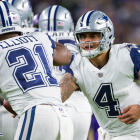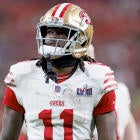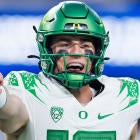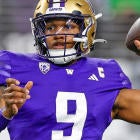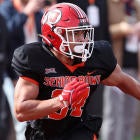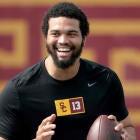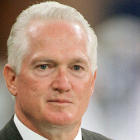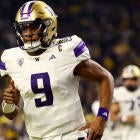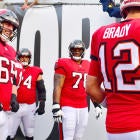Way back in Week 1, the New York Giants beat the Dallas Cowboys 20-19 by doing something no other team has been able to do since: They shut down Ezekiel Elliott and Dak Prescott at the same time. In their NFL debuts, Elliott averaged 2.5 yards per carry (25 for 51 yards) and Prescott completed only 55.6 percent of his passes while averaging just 5.04 yards per pass attempt (227 on 45 attempts). Each of those figures is, by far, the lowest of the season for either player.
Elliott has averaged at least 4 yards per carry in every subsequent game but one (3.9 against the Ravens) and is averaging 4.9 yards for the season. He's leading the NFL in rushing and is within shouting distance of Eric Dickerson's all-time rookie record.
Meanwhile, Prescott has finished only one other game south of a 66.7 percent completion rate (48.7 against the Eagles) and has yet to throw for less than 7.4 yards per attempt. He's working on season-long figures of 68 percent and 8.3 yards per attempt. He is, by most any measurement, having one of the best seasons a rookie quarterback has ever had.
All of which is to say that the Cowboys offense that will take the field against the Giants this Sunday is a whole lot different than the one the G-Men stifled in the season opener.
Those Cowboys operated from a conservative shell, the byproduct of not wanting to ask Prescott to do too much too soon. Those Cowboys had Elliott trying to turn every play into a home run, either impatiently outrunning his blockers or tiptoeing too tentatively behind them while searching for an obvious crease that would never develop.
The Cowboys of the past 11 games, all Dallas victories, have operated at full-throttle, full-time, pressuring defenses into mistakes they can't afford to make. They've had Prescott spraying the ball to all areas of the field and Elliott taking every inch the defense gives him and more. There's a reason the Boys rank fifth in yards per game and fourth in points per game despite having run fewer drives than the average NFL team. They're efficient and they're explosive (6.2 yards per play overall and an NFL-high 75 "big plays"), and if it seems like they always have the ball, it's probably because they do.
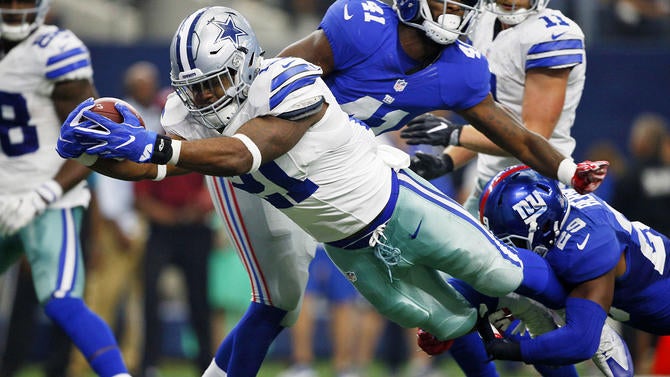
When considering the Cowboys offense, it is important, of course, to pay proper deference to the offensive line. And not just, "the offensive line," but the actual guys that comprise it.
While it may be the most attention-lavished line in recent memory, it's not often that the five individuals get singled out for praise. It's usually just the collective. So let's say here that if Tyron Smith isn't the best left tackle in football, it's only because Joe Thomas still exists. The same is true of guard Zack Martin, for whom only Marshal Yanda and Kelechi Osemele really stand in the way of the title. Travis Frederick probably is the best center in the NFL. Ronald Leary has not just filled in capably for the injured La'el Collins, but played as well as nearly any guard in the league. And Doug Free has been ... fine. (It's pretty incredible that the Cowboys' line could be collectively this good with such an obviously weak link, but that's how good the other four guys have been.)
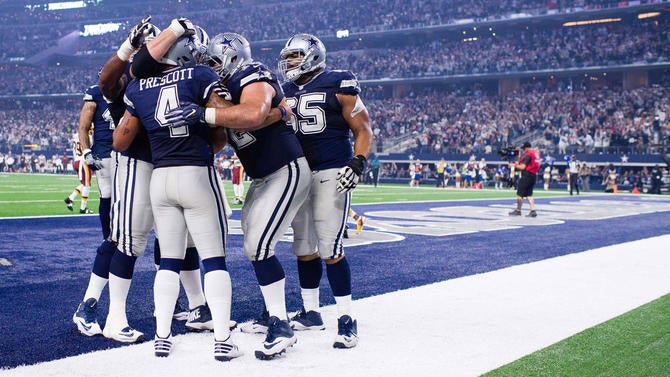
It's going too far to say that the guys up front are the only reason Elliott and Prescott have been able to find such great success as rookies, but their work has certainly given the star duo the space and the time to let their skills shine. As Bill Barnwell noted last month, many of Elliott's biggest gains come on plays where he is totally untouched -- some of his running lanes are wide enough to fly the team plane through.

Prescott has been pressured at a slightly above-average rate compared to other quarterbacks, but part of that is that he tends to hold onto the ball longer than other passers. His average of 2.92 seconds to pass, per Pro Football Focus, is fourth highest among qualified QBs. One of his best skills is hanging in the pocket, surveying the field and finding secondary or tertiary options when his initial read is covered. To be able to execute at that level, you need to be well-protected. More often than not, Prescott is afforded that luxury.
None of that is to say that what either Elliott or Prescott is doing is easy, though.
Elliott has a rare combination of vision, power and speed, and he's able to extend plays either by zooming away from defenders or simply running through them. He's averaging 2.83 yards after contact, fifth among the 32 running backs with at least 100 totes. He has been at his most effective when running anywhere between Martin and Smith (we would say "between the tackles," but he hasn't been very effective running between Martin and Free on the right side), but he has also repeatedly shown the ability to string runs out all the way to the sideline before bursting up the field for a few yards that it doesn't look like he should be able to get.

Much like the Dallas offense as a whole, Elliott has been efficient and explosive. He ranks first in Football Outsiders' success rate and third in DVOA, which means he is getting both the yards needed to keep the offense on down-and-distance schedule and breaking long runs as well. He is both the guy that wears the defense down and the one that takes advantage of that fact by hitting the home run play.
So far, this all sounds like the Cowboys offense is basically a carbon copy of the 2014 version that led them to a 12-4 record and the NFC East title, only with the two star rookies subbed in for DeMarco Murray and Tony Romo. And in a sense, that's true. But there is another big difference aside from the presence of Elliott and Prescott: formations.

The 2014 Cowboys had two or more tight ends on the field for 48 percent of their plays, per Pro Football Focus. James Hanna and/or Gavin Escobar were usually out there, whether the play was a run or a pass. That alignment allowed the Cowboys to compensate for the somewhat obvious design of some of their running plays by getting extra blockers on the field, and it provided an element of surprise when they decided to go play-action. It worked wonderfully on all levels.
This year's Cowboys have structured their attack in a different way. They've had multiple tight ends on the field for only 33 percent of their plays, and have leaned on "11" personnel (one back, one tight end) far more often. Doing so has helped them get Cole Beasley more snaps, which has opened up their offense both on the ground and through the air.
The difference is incredibly stark. Beasley has already been on the field for more snaps in 2016 than he was in 2014. Not only that but Hanna and Escobar combined for 157 more snaps than Beasley in 2014. In a massive reversal, Beasley has already out-snapped Escobar and Geoff Swaim by 157 combined snaps so far this season. It's a swing of almost 25 snaps per game.

Because Beasley has proven so dangerous in the short and quick passing game, his presence on the field typically forces opposing defenses to remove a linebacker and insert an extra defensive back. That makes Elliott's running lanes up the middle even wider than they might normally be. And because smart defenses roll much of their coverage toward Dez Bryant and/or Jason Witten, Beasley is often left one-on-one in the slot, and usually against defenders that are no match for his quickness.
Beasley actually has as big a target share in "11" personnel (26 percent) as Bryant. Against certain defensive looks, he has practically become a co-No. 1 option. There's a reason Prescott is 27 of 31 for 276 yards with five touchdowns and no picks (141.3 passer rating) when targeting Beasley on out routes.
While Beasley works the short game, Bryant, Witten and Terrance Williams are Prescott's usual targets in the intermediate range and beyond. Prescott has been excellent throwing short and medium-length routes all season, and after starting just 1 of 7 for 29 yards on deep passes through the first four games of the season, he has rebounded to complete 11 of 25 attempts for 290 yards and three touchdowns on those throws over the past eight games. (Nearly half of those throws are in Bryant's direction, by the way. If Prescott is going deep, more often than not he's looking for No. 88.) He now has to be considered a strong thrower to all areas of the field.

There doesn't really seem to be a way to consistently rattle him, short of getting defenders directly into his face, which is a problem for every quarterback. And even then, it's not like Prescott has totally collapsed under pressure. And because the Cowboys line is so good, defenses often have to send extra rushers in order to get pressure in the first place, and Prescott has systematically destroyed blitzes.
Per Pro Football Focus, he has completed 66 percent of his passes against the blitz at 9.4 yards per attempt, while throwing eight touchdowns and no picks. And those 138 blitzes have resulted in all of eight sacks. That just doesn't seem worth it.
Of course, we would be remiss if we didn't mention Prescott's effect on the running game. He doesn't necessarily have uber-explosive rushing numbers himself (35 carries for 235 yards and five scores on non-kneeldowns), but the threat of him taking off around the edge has added a distinct new element to the Dallas running game, and has played a role in the massive creases Elliott sometimes sees.
Dallas likes to reserve Prescott's read-option carries for the red zone, where he can either pull the ball out if he knows he's going to run untouched into the end zone or for a first down, or just give it to Elliott and let him barrel through the line. That puts a ton of pressure on the outside defender to play two dangerous runners at once and it has the added benefit of saving Prescott from taking huge hits in the middle of the field.

Prescott has been selective about when to scramble if his protection breaks down or if nobody comes open quickly, most often keeping his eyes down the field while stepping up through or escaping from the pocket to the outside. He really only runs as a last resort, and it's difficult to remember him taking any big hits when he has done so. Unlike some other mobile quarterbacks, he already has a pretty good feel for when to slide or duck out of bounds.
In addition to all that talent and all the matchup advantages that talent creates, the Cowboys are also playing good situational football and have benefited from good play-calling, give or take some rather obvious short-yardage formations.

Coach Jason Garrett and offensive coordinator Scott Linehan have put their guys in position to succeed more consistently than almost any other offensive coaches, and the players on the field have taken advantage. This is a group that has come a long way since it was shut down in Week 1, and it's more likely than not that they'll show that on the field against the Giants on Sunday night.













